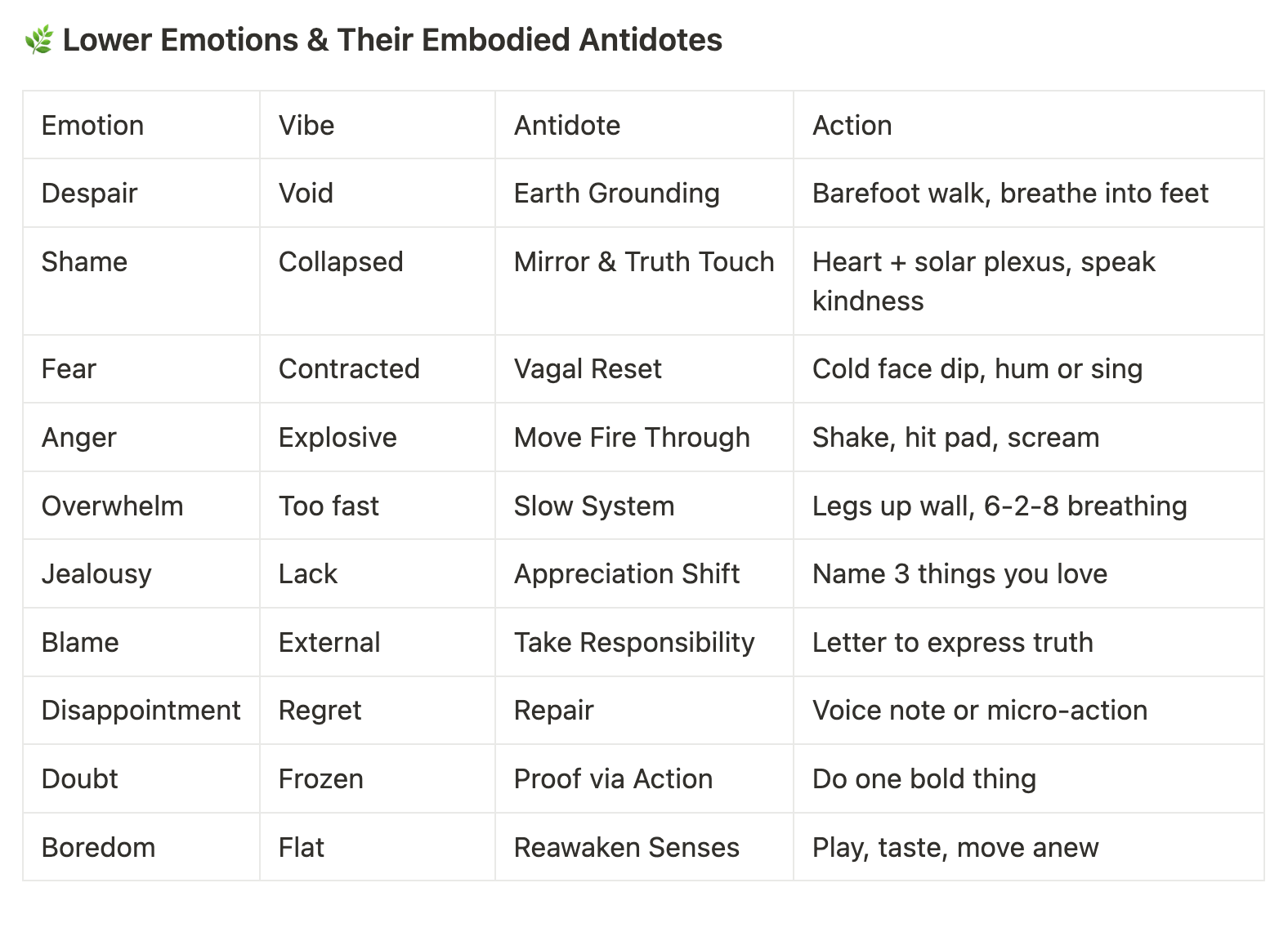The Alchemist's Blueprint | A Comprehensive Guide to Emotional Transformation

Transmuting emotion into power, pain into purpose, and wounds into wisdom
Table of Contents
- Understanding Emotions
- The Nature of Core Wounds
- The Alchemy Loop: Four-Step Transformation Process
- Discernment: Past Wound vs. Present Truth
- Self-Regulation Techniques
- Breaking Self-Sabotage Patterns
- Communication During Emotional Intensity
- Byron Katie's Four Questions Method
- Daily Practice and Integration
Understanding Emotions
The Truth About Emotions
Emotions are not inherently good or bad—they are energy in motion, designed to move through us rather than define us. When we allow ourselves to feel, move, and express emotions authentically, they become our greatest source of power, wisdom, and guidance.
Every Emotion is a Messenger
Rather than viewing difficult emotions as problems to fix, consider them as messengers carrying important information about unmet needs. Every emotional response is feedback from your inner system communicating:
- "Something here isn't aligned"
- "A need is unmet"
- "Let's come back into wholeness"
Core Emotional Messages
Understanding what emotions are truly communicating:
- Anxiety → A body asking for safety
- Shame → A soul asking to be seen
- Loneliness → A heart asking for connection
- Anger → Passion that needs a mission
- Emptiness → Purpose waiting to be born
- Triggers → Teachers in disguise
The Nature of Core Wounds

What Are Core Wounds?
Core wounds are not your fault, but healing them is your freedom. They result from emotional ruptures in childhood, relationships, or systemic conditioning—moments where love, safety, or worth weren't adequately met or protected.
These wounds silently create patterns until we meet them with presence, responsibility, and compassion.
The Core Thread
At the heart of all emotional dysregulation lies this fundamental truth: "Unmet needs from the past echo through the present."
Our nervous system reacts not just to current experiences, but to past experiences that remain unhealed. When present situations mirror past pain (even subtly), the nervous system overreacts to "protect" you—responding to memory and meaning rather than the current moment.
The Alchemy Loop
Four-Step Transformation Process: TRIGGER → TRUTH → TRANSMUTATION
1. NAME IT – Awareness Breaks the Spell
- Speak or write what you're experiencing
- Examples: "This is shame," "This is fear," "This is old scarcity showing up"
- This interrupts the autopilot emotional loop
2. FEEL IT SOMATICALLY – The Body Never Lies
Physical practices to process emotion:
- Breathwork: 4-4-8 breathing pattern
- Movement: Ocean dip, squats, shaking, running
- Grounding: Hand on heart and belly, affirming "I'm safe to feel this now"
3. REPLACE OLD COPING – Choose Nourishing Action
- Break destructive patterns
- Swap numbing behaviors for healthy expression
- Replace shame-based responses with truth-based actions
4. ANCHOR IT IN TRUTH – Integrate the Lesson
Reflective questions for integration:
- "What did I need that I didn't ask for?"
- "What did I do differently this time?"
- "What would my future self thank me for?"
Alternative Four-Step Ritual
Witness the Energy → "I feel ___ and that's okay"
Name the Need → "What do I need that I didn't receive?"
Choose the Channel → Move it (body), voice it (expression), or create with it (art, service, action)
Offer it to Growth → "What is life inviting me to grow into through this?"
Discernment Guide
Determining: Past Wound or Present Truth?
1. Body Scan: Is It a Familiar Sensation?
- If yes → Likely past-based (trauma echo or emotional imprint)
- If no → May be present-based (real-time boundary crossing or value misalignment)
2. Thought Patterns: Are They Exaggerated or Timeless?
Past-wound thoughts sound like:
- "Always/never" statements
- Catastrophic predictions
- Identity-based accusations
Present-based thoughts sound like:
- Specific and situational
- Solution-focused
- Proportionate to the event
3. Trigger Scale: Is the Reaction Bigger Than the Event?
- If yes → Your history is hijacking your present
- If no → You're likely responding from presence and clarity
4. Inner Child Check-In: Who's Driving?
Ask yourself: Does this feel like a young, scared part of me is responding, or am I responding as my adult, integrated self?
5. Pattern Recognition: Same Story, Different People?
- If yes → You may be replaying an old narrative or trauma pattern
- If no → The moment may genuinely be asking for a shift or decision
Self-Regulation Techniques
Immediate Response Checklist When Triggered
1. Pause + Breathe
- Ask: "Am I safe right now?"
- Deep inhale, long exhale to reset the nervous system
2. Track the Pattern
- Ask: "Have I felt this before?"
- Name the wound: Abandonment, Rejection, Injustice, Shame, Betrayal
3. Check the Story
- Is this true now, or is this an old fear?
- Ask: "If this were my best friend, what would I tell them?"
4. Respond from Wholeness
- Speak with vulnerability, not projection
- Act from self-trust, not self-protection
When You're Unsure
- Consult trusted mentors or mirrors for outside perspective
- Journal or voice-record your thoughts for clarity
- Wait 24 hours before acting on highly charged emotions
- Track the root of discomfort: Is it about them, or is it a mirror of your inner state?
Breaking Self-Sabotage Patterns
Why We Sabotage Beautiful Things
1. Core Wounds Reacting
Unconscious beliefs that filter reality:
- "I'm not enough"
- "I don't deserve this"
- "They'll leave anyway"
- "It won't last"
2. Fear of Intimacy or Success
- Fear of being fully seen due to past pain
- Fear of rising too high in case of falling
- Choosing familiar discomfort over unknown joy
3. Testing Behaviors
- Picking fights to prove abandonment fears
- Acting aloof to regain control
- Withdrawing when things feel good
- Overthinking until magic disappears
4. Self-Fulfilling Prophecies
Creating situations that confirm limiting beliefs
5. Ancestral/Karmic Patterns
- Repeating learned relational dynamics
- Carrying trauma that wasn't originally yours
- Finding safety in chaos if that defined early love
Breaking the Sabotage Loop
- Learn the lesson with gratitude → Once you see the pattern, you don't need to repeat it
- Create a new choice → Replace old reactions with new actions
- Anchor in embodiment → Think, act, and feel differently to rewire the nervous system
- Reclaim your power → Stop outsourcing your peace, love, or truth
Healing Affirmations
- "I'm allowed to feel safe, seen, supported, and loved—even if it's unfamiliar"
- "I choose not to ruin good things just because the old me couldn't trust them"
- "Peace isn't boring. Love isn't chaos. Safety isn't weakness"
Communication During Emotional Intensity
Framework for Connection During Triggers
Step 1: Catch the Charge
Notice physical signs:
- Clenched jaw, tight chest, racing thoughts
- Urge to attack, withdraw, or defend
- Body saying "I'm not okay right now"
Step 2: Call a Gentle Timeout
Communicate need for regulation without shutting down:
- "I'm feeling really activated right now. I don't want to hurt you or say something I don't mean, so I need a moment to regulate"
- "I'm noticing I'm in a trigger. Can we pause and come back to this once I've had a breath?"
- "I love you, and I want to talk about this. I just need to find my center first"
Step 3: Self-Regulate
Take 2-20 minutes as needed:
- Deep breathing (4-7-8 or box breathing)
- Cold water, gentle movement, grounding touch
- Ask: "What am I really feeling?" (Anger often masks fear, grief, shame, or sadness)
Step 4: Share Imperfectly with Ownership
Use this structure: "When [situation], I felt [emotion], because [story/need]. What I really needed was [need/request]."
Example: "When you didn't reply, I felt rejected—because part of me assumed I wasn't a priority. What I really needed was reassurance that we're still okay."
Step 5: Reconnection Loop
After repair, return to:
- What you love about them
- Appreciation for the repair process
- Physical anchoring (eye contact, hug, touch)
- Shared breath or laughter if appropriate
Emergency Scripts When Too Activated to Talk
- "I want to respond with love, not reaction. I'll check back in soon"
- "I care too much to do this poorly. I'll come back when I can meet you with presence"
- "Please don't take my space as distance. It's so I can meet you in truth"
Byron Katie's Four Questions
When Emotions Are High, Ask:
1. Is it true?
Question the thought causing suffering (e.g., "They don't care about me," "I always mess things up")
2. Can I absolutely know that it's true?
Challenge certainty and open space for curiosity. Truth stands up to inquiry—stories don't.
3. How do I react—what happens—when I believe that thought?
Notice how your body, emotions, and behaviors shift. Do you tense? Dissociate? Attack? Withdraw?
4. Who would I be without that thought?
Imagine the freedom, peace, and clarity if the thought wasn't believed. Who might you become? How might you respond instead?
The Turnaround
After the four questions, flip the thought to its opposite or a more empowered version.
Example:
- Thought: "They don't respect me"
- Turnarounds: "I don't respect me" or "I don't respect them" or "They do respect me"
Each turnaround offers opportunity to see where your mind projects what hasn't been fully processed or healed.
Daily Practice and Integration
Daily Alchemy Prompts
- "What am I feeling?"
- "Where do I feel this in my body?"
- "What does this feeling need from me?"
- "What loving action can I take instead?"
Core Reframes
- Emotions are not the enemy—they are messengers
- Triggers are not regressions—they are activations
- Pain is not punishment—it is a portal to power
- Emotions are data, not identity
- Feelings are real but temporary—like clouds passing through the sky
Truth Anchors
"Emotions are not reality. Feelings are fleeting."
Remember:
- Emotions are real but temporary messengers, not truth-bearers
- Feelings often arise from past experiences, not current threats
- The body keeps the score of trauma, but that doesn't mean you're still there
- Much of what you feel today may be your nervous system reacting to yesterday
- You can feel without believing everything you feel
- You can witness without becoming what you feel
Integration Mantra
"I am not my past.
I witness my feelings without becoming them.
I respond from truth, not trauma.
I am safe to choose differently now."
Final Wisdom
Remember:
- You are not your past
- You are not your wounds
- You are not broken—you are breaking through
- Every beautiful thing worth keeping will invite your shadows to surface—not as a sign to run, but as an invitation to heal and stay
- The strength of any connection lies in repair, communication, and the willingness to meet each other in truth
- Truth is the highest form of intimacy
The Sacred Work
You are the alchemist of your own experience. You're not just healing yourself—you're transmuting what generations passed down unconsciously. You are creating space for your soul, your children, and the world to breathe a little freer.
And that, my friend, is sacred.
